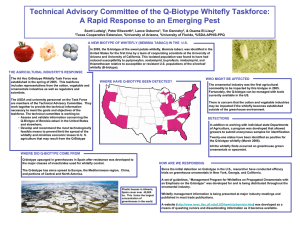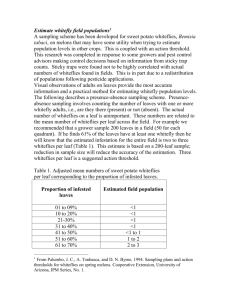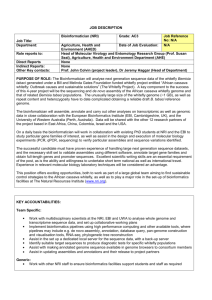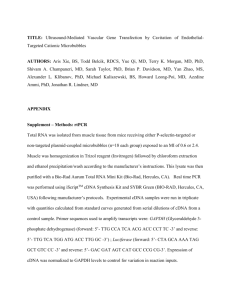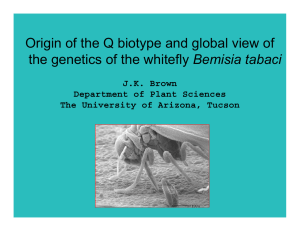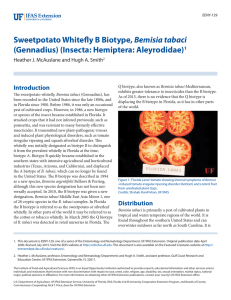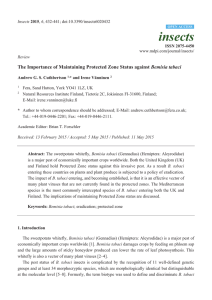Mutualistic benefit to B biotype Bemisia tabaci for
advertisement
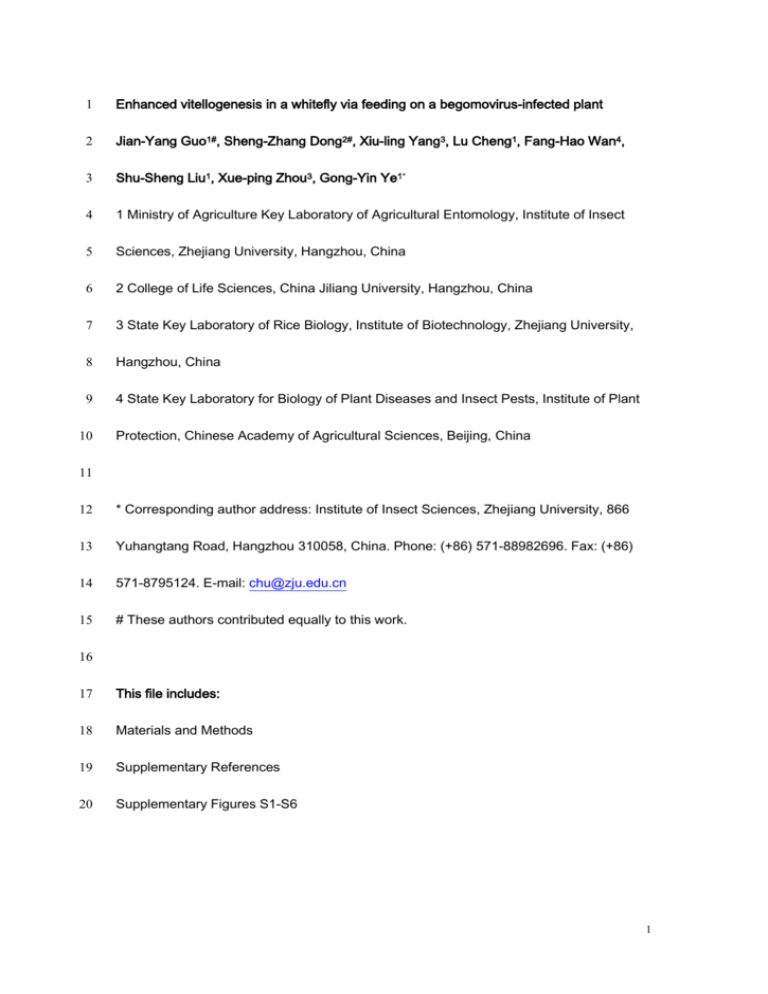
1 Enhanced vitellogenesis in a whitefly via feeding on a begomovirus-infected plant 2 Jian-Yang Guo1#, Sheng-Zhang Dong2#, Xiu-ling Yang3, Lu Cheng1, Fang-Hao Wan4, 3 Shu-Sheng Liu1, Xue-ping Zhou3, Gong-Yin Ye1* 4 1 Ministry of Agriculture Key Laboratory of Agricultural Entomology, Institute of Insect 5 Sciences, Zhejiang University, Hangzhou, China 6 2 College of Life Sciences, China Jiliang University, Hangzhou, China 7 3 State Key Laboratory of Rice Biology, Institute of Biotechnology, Zhejiang University, 8 Hangzhou, China 9 4 State Key Laboratory for Biology of Plant Diseases and Insect Pests, Institute of Plant 10 Protection, Chinese Academy of Agricultural Sciences, Beijing, China 11 12 * Corresponding author address: Institute of Insect Sciences, Zhejiang University, 866 13 Yuhangtang Road, Hangzhou 310058, China. Phone: (+86) 571-88982696. Fax: (+86) 14 571-8795124. E-mail: chu@zju.edu.cn 15 # These authors contributed equally to this work. 16 17 This file includes: 18 Materials and Methods 19 Supplementary References 20 Supplementary Figures S1-S6 1 21 MATERIALS AND METHODS 22 Whitefly 23 The MEAM1 (mtCO1 GenBank accession no: GQ332577), MED (mtCO1 GenBank accession 24 no: DQ473394) and Asia II3 (mtCO1 GenBank accession no: DQ309077) cryptic species of 25 the whitefly species complex Bemisia tabaci (Gennadius) were used [1-3]. Stock whitefly 26 cultures were maintained on cotton (Gossypium hirsutum L.) cv. Zhemian 1973 in separate 27 climate chambers at 26ºC (± 1 ºC), 40–60 % RH and L: D 14 h: 10 h light regime. The purity of 28 the cultures was checked every 3-5 generations using a random amplified polymorphic 29 DNA-polymerase chain reaction (RAPD-PCR) [1, 4]. Measures were taken to use only pure 30 sub-cultures of the MEAM1, MED and ASIA II3 for experiments. Non-viruliferous whitefly 31 colonies were reared separately under the same conditions as described above. 32 Virus inocula 33 Infectious clones of TYLCCNV and their satellite DNA molecules (named TYLCCNB) 34 constructed previously [5, 6] were used as inocula, and the viruses were maintained on plants 35 of tobacco (Nicotiana tabacum L.) cv. NC89 at 26ºC (± 1 ºC), 40–60 % RH and L: D 14 h: 10 h 36 light regime. 37 Plants 38 Tobacco cv. NC89, a host plant of TYLCCNV, and a non-host plant, cotton (cv. Zhemian 1973), 39 were used. Uninfected tobacco and cotton plants were grown under natural light and controlled 40 temperature in insect-proof greenhouses [3]. The virus-infected tobacco plants were obtained 41 by inoculating with TYLCCNV and TYLCCNB at the 4-5 true-leaf stage as previously described 42 [5-7]. Both uninfected and TYLCCNV-infected tobacco plants were grown to the 6-7 true-leaf 43 stage for experiments. The virus infection status of the test plants was judged by the 44 characteristic symptoms, further confirmed by molecular markers as previously described [3]. 45 All plants were watered every 3-4 days as necessary and fertilized once a week. All 46 experiments were conducted at 26ºC (± 1 ºC), 40–60 % RH and L: D 14 h: 10 h light regime. 47 Virus purification 48 Nicotiana benthamiana plants at 30 days post inoculation with TYLCCNV and TYLCCNB were 49 used as the source for virus purification. The process of virus purification was modified from 50 one of our previous studies [8]. Leaf and stem tissues were frozen in liquid nitrogen and 2 51 homogenized using ice-cold buffer containing 500 mM sodium phosphate, pH7.5, 1 mM EDTA, 52 and 0.1% (v/v) 2-mercaptoethanol. The extract was squeezed through four layers of muslin, 53 followed by a 20-min centrifugation at 6,000 g. The supernatant was clarified by the addition of 54 2.5% Triton X-100, 0.1 M sodium sulfite, and 10% (v/v) cold chloroform followed by a 10-min 55 centrifugation at 8,000g. The supernatant was stirred overnight with 7% PEG6000, and 56 centrifuged at 11,000 g for 15 min. The pellets were resuspended thoroughly in 0.5 M sodium 57 phosphate containing 0.01 M magnesium chloride and 0.5 M urea. Virus suspension was 58 layered on top of 20-30% sucrose cushion and centrifuged at 3,3000 g for 2 h. Pellets were 59 suspended in 0.01 M phosphate buffer and used for further analysis. The virus was further 60 confirmed by PCR using the method previously published [6]. Inactivated viron was acquired 61 by sterilizing at 121 ºC for 20min and stored at 4 ºC before being used. 62 Egg samples 63 Newly laid eggs (2-3 h old) of MEAM1 were brushed from the surface of cotton leaves and 64 collected into a sterilized Eppendorf microcentrifuge tube in an ice bath. To extract vitellin, the 65 eggs were homogenized with a glass rod in 100 μl phosphate buffered saline (PBS, pH 7.4) 66 with 2 μl of a protease cocktail containing 0.1 M phenylmethyl sulfonyl fluoride (PMSF) 67 (AMRESCO). Subsequently, the mixture was centrifuged at 12,000 g for 30 min at 4 ºC; the 68 supernatants were collected and the protein concentration was determined with the Bio-Rad 69 protein assay kit (Bio-Rad, USA) using bovine serum albumin (BSA) as a standard. And then, 70 the supernatants were stored at -70 ºC before being used. 71 Gel electrophoresis 72 Characterization of vitellin 73 Native-polyacrylamide gel electrophoresis (PAGE) was carried out on a 4-20 % gradient gel 74 with a 4 % spacer gel (Bio-Rad). After electrophoresis, proteins were stained with Coomassie 75 brilliant blue R-250. To test the presence of carbohydrate, lipid and phosphorus components, 76 the gels were stained using GelCode® glycoprotein (Pierce, USA), Sudan black B and 77 GelCode® phosphoprotein (Pierce, USA) respectively, following the methods described in the 78 kit protocol. 79 Characterization of vitellogenin 80 SDS-PAGE gel electrophoresis was preformed with 8 % separation gel and 4% spacer gel. 3 81 The gels were run at 100 V for 2 h at 4 ºC with a Mini-PROTEAN® 3 Electrophoresis cell 82 (Bio-Rad, USA), and visualized with Coomassie brilliant blue R-250. The gel was 83 photographed and analyzed using Gel DomTM XR+ Imaging system (Bio-Rad, USA). 84 Western blot 85 After electrophoresis, proteins separated on native-PAGE or 8 % SDS–PAGE gels were 86 blotted onto nitrocellulose membrane in buffer C (25 mM Tris, pH 8.3; 192 mM glycine; 10% 87 methanol) at 16V for 20 min, running on a Trans-Blots SD semi-dry transfer cell (Bio-Rad). The 88 membrane was subsequently incubated with the purified monoclonal antibodies against 89 MEAM1 Vt at 1:5,000 dilution for 60 min at 37ºC, followed by incubation with horseradish 90 peroxidase (HRP)-conjugated goat anti-mouse IgG (Sigma) at 1:10,000 dilution for 60 min at 91 37ºC. The color was developed using 3, 3, 5, 5-Tetramethylbenzidene (TMB) (Promega) [9]. 92 Preparation of antibodies 93 Polyclonal antibody 94 Following the method of Dong et al. [9], rabbit serum was prepared against Vt. The serum was 95 made female specific by absorbing whole male homogenate solution using the method of Wu 96 and Ma [10] and was purified by a PROSEP-A spin columns (Millipore). The serum titer had an 97 enzyme linked immunosorbent assay (ELISA) end point of 1:68,000 by indirect ELISA. The 98 female specificity to Vg was verified using Western blotting analysis. 99 Monoclonal antibody 100 The purified Vt with a final concentration of 1 mg/ml were used as antigen for preparing 101 monoclonal antibodies following the method described by Dong et al. [9]. The hybridomas 102 were screened for production of Vt-specific antibody using indirect ELISA and Western blotting. 103 All the cell lines were propagated for ascites production and liquid nitrogen vapor phase 104 cryogenic storage. 105 Purification of antibodies 106 To obtain purified monoclonal antibody, 4 ml of ascites were mixed thoroughly with an equal 107 volume of saturated ammonium sulfate solution overnight at 4 °C, centrifuged at 10,000 g for 108 10 min. The precipitate was dissolved in 2ml PBS and dialysed at 4 °C with the same buffer for 109 24 h. Following dialysis, insoluble material was removed by centrifuge at 10,000 g for 10 min. 110 The supernatant was applied to UNOTM Q1 ion exchange column (Bio-Rad) which had been 4 111 equilibrated in buffer B (10 mM Tris-HCl, pH 8.2). The column was eluted with a linear NaCl 112 (0.1-1 M) in buffer B (pH 8.2). The purity of the antibody was identified by SDS–PAGE. In 113 addition, the immunoglobulin subclass of the antibody was determined using a goat 114 anti-mouse IgG (H+L chain specific) kit (Southern Biotech, USA) by indirect ELSA. 115 Sequencing of Vitellogenin cDNA 116 RNA isolation and synthesis of the first stand cDNA 117 Total RNA was extracted using Trizol Reagent and further purified with the RNeasy-Mini Kit 118 (Qiagen). Briefly, two hundreds of ovaries of adult females were dissected individually by 119 tearing the epidermis in a drop of cold DEPC buffer. They were then collected into RNAse free 120 glass tube for isolating total RNA. The RNA samples were quantitated using a Nanodrop 121 spectrophotometer (Nanodrop Technologies, USA). The first strand cDNA were synthesized 122 reverse transcribed in 20 μl reaction mixtures containing reaction buffer, oligo (dT)18 (10 mM), 123 dNTP mixture (10 mM) and reversetranscriptase from avian myeloblastosis virus (AMV, 20 124 units) (Takara, Japan). The cDNA were then used as a template to generate target gene from 125 an in vitro PCR. 126 Primers and contigs 127 Based on the published partial amino-acid sequences of B. tabaci Vg [11] and conserved 128 sequence of other Hemiptera insects, two pairs of degenerate primers including Vg-sense 129 primer1 (5’-ACN GGY GAY TGY GAR AC-3’), Vg- sense primer 2 (5’-ACA RAA AGC YGA RGT 130 HYA CAG-3’), Vg-Reverse primer 1 (5’-GTR DGT CAT TTC AGC CAT-3’) and Vg- Reverse 131 primer 2 (5’-GGC ATR TTR TTR GGR TTY TG-3’) were designed. Vg contigs were acquired 132 after the PCR and assembled with an overlap of at least 200 base pairs. 133 Rapid amplification of cDNA ends 134 Based on cDNA sequence data obtained from the PCR product, the gene specific primers 135 VgR1 (5’-TAG CCA TTT GTT TAG TCG TT-3’) and VgR2 (5’-CTG GGT TTC AGC ATT ATT 136 CAG GTG TTC-3’) were synthesized for 5’-RACE; VgS1 (5’-TAC TCG GTA ACG ACT AAA 137 CAA A-3’) and VgS2 (5’-CTT CAG GAT ATG GCT CAA CA-3’) were synthesized for 3’-RACE. 138 The amplification conditions used were 5 min at 94°C, followed by 33 cycles of 30 s at 94°C, 139 30 s at 55°C, and 2 min at 72 °C, then 10 min at 72 °C for 5’-RACE; 5 min at 94°C, followed by 140 33 cycles of 30 s at 94°C, 30 s at 58°C, and 5 min at 72°C, then 10 min at 72°C for 3’-RACE. 5 141 All of the above were followed instructions of the smart RACE Kit (Clontech, America). After 142 PCR, products were separated by electrophoresis, DNA bands corresponding to 143 approximately 1300 bp (for 5’-RACE) and 4500 bp (for 3’-RACE) were excised from the 144 agarose gel and purified using a DNA gel extraction kit (Omega, USA). These PCR products 145 were cloned into the pGEM-T-easy vector (Promega, USA) and sequenced by the 146 dideoxynucleotide method. To confirm the validity of the sequence data obtained, each 147 fragment was sequenced at least three times. The overlapping sequences from PCR were 148 assembled to obtain a full-length cDNA sequence of one subunit of Vg in MEAM1. 149 Deduced amino acid sequence and phylogenetic analysis of Vg genes. 150 The sequence of MEAM1 Vg cDNA was compared with those of other Vg sequences 151 deposited in GenBank using the ‘‘BLAST-N’’ or ‘‘BLAST-X’’ tools available on the National 152 Center for Biotechnology Information (NCBI) website. The amino-acid sequence of MEAM1 Vg 153 was deduced from the corresponding cDNA sequence using the translation tool at the ExPASy 154 Proteomics website (http:// www.expasy.org/tools/dna.html). Other protein sequence analysis 155 used in this study, including molecular weight (MW), isoelectric point (PI) and multiple 156 sequence alignments of deduced amino-acid sequence, was performed using MEGA 4.0 157 software [12]. The position of the signal peptide in the Vg was predicted using the Signal IP 158 computer program on the website: http://www.cbs.dtu.dk/services/SignalP. 159 Supplementary References 160 1. Xu J, De Barro PJ, Liu SS (2010). Reproductive incompatibility among genetic groups of 161 Bemisia tabaci supports the proposition that the whitefly is a cryptic species complex. Bull 162 Entomol Res 100: 359-366. 163 2. Liu J, Zhao H, Jiang K, Zhou XP, Liu SS (2009). Differential indirect effects of two plant 164 viruses on an invasive and an indigenous whitefly vector: implications for competitive 165 displacement. Annals Appl Biol 155: 439-448. 166 3. 167 168 169 Jiu M, Zhou XP, Tong L, Xu J, Yang X, et al. (2007). Vector-virus mutualism accelerates population increase of an invasive whitefly. PLoS One 2: e182. 4. Zang LS, Liu SS, Liu YQ, Chen WQ (2005). A comparative study on the morphological and biological characteristics of the B biotype and a non-B biotype (China-ZHJ-1) of 6 170 Bemisia tabaci (Homoptera: Aleyrodidae) from Zhejiang, China. Acta Entomol Sin 48: 171 742-748. 172 5. 173 174 infection but intensifies symptoms in a host-dependent manner. Phytopathol 95: 902-908. 6. 175 176 Li ZH, Xie Y, Zhou XP (2005). Tobacco curly shoot virus DNAβ is not necessary for Cui XF, Tao XR, Xie Y, Fauquet CM, Zhou XP (2004). A DNAβ associated with tomato yellow leaf curl China virus is required for symptom induction. J Virol 78: 13966-13974. 7. Zhou XP, Xie Y, Tao XR, Zhang ZK, Li ZH (2003). Characterization of DNA beta 177 associated with begomoviruses in China and evidence for co-evolution with their cognate 178 viral DNA-A. J Gen Virol 84: 237-247. 179 8. 180 181 Zhou XP, Chen JS, Li DB, Li WM (1994) A method of purification of potyviruses with high yield. Chinese Microbiol 21: 184–186. 9. Dong SZ, Ye GY, Zhu JY, Chen ZX, Hu C, et al. (2007). Vitellin of Pteromalus puparum 182 (Hymenoptera: Pteromalidae), a pupal endoparasitoid of Pieris rapae (Lepidoptera: 183 Pieridae): Biochemical characterization, temporal patterns of production and degradation. 184 J Insect Physiol 53: 468-477. 185 186 187 10. Wu SJ, Ma M (1986). Hybridoma antibodies as specific probes to Drosophila melanogaster yolk polypeptides. Insect Biochem 16: 789-795. 11. Leshkowitz D, Gazit S, Reuveni E, Ghanim M, Czosnek H, et al. (2006). Whitefly (Bemisia 188 tabaci) genome project: analysis of sequenced clones from egg, instar, and adult 189 (viruliferous and non-viruliferous) cDNA libraries. BMC Genom 7: 79. 190 191 12. Tamura K, Dudley J, Nei M, Kumar S (2007). MEGA4: molecular evolutionary genetics analysis (MEGA) software version 4.0. Mol Biol Evol 24:1596-1599. 192 7 193 194 Supplementary figure legends 195 Figure S1 Characterization of MEAM1 whitefly Vt. 196 Native-PAGE (linear gradient consisting of 4–25% polyacrylamide) analysis with Coomassie 197 brilliant blue staining (left) and the characterization of yolk soluble protein (right), Vt bands 198 were visualized by staining with Coomassie brilliant blue (C), Sudan Black B (L), Periodic 199 acid-Schiff’s reagent (P) and Methyl Green Solution (G). The soluble proteins sampled from 200 eggs (E), ovaries (O), female (F) and male (M) adults 6 d after eclosion. PM: high molecular 201 weight standards (Amersham). Arrows indicate the bands of Vg or Vt. 202 203 Figure S2 Purification of monoclonal antibody against MEAM1 whitefly Vt. 204 SDS–PAGE of the purified monoclonal antibody IgG against B. tabaci Vt with Coomassie 205 brilliant blue staining. PM: Molecular weight standards; A: purified IgG; B: crude ascites fluid; H 206 and L: IgG heavy and light chain. 207 208 Figure S3 Distribution of Vg/Vt in different tissues of MEAM1 whitefly. 209 SDS–PAGE analysis with Coomassie brilliant blue staining (left) and corresponding Western 210 blotting analysis (right) with the monoclonal antibody against B. tabaci Vt for soluble proteins 211 sampled from different tissues of the female and male. PM: prestained molecular mass 212 markers (Bio-Rad); E: egg extract; H and O: female hemolymph and ovaries 6 d after eclosion; 213 F and M: soluble protein of female and male adults 6 d after eclosion; Arrow indicates subunits 214 of Vg or Vt. 215 216 Figure S4 Immune reaction of Vt antibody with yolk protein of MED and ASIA II3 217 whiteflies. 218 SDS–PAGE analysis with Coomassie brilliant blue staining (left) and corresponding Western 219 blotting analysis (right) with the monoclonal antibody against B. tabaci Vt for soluble proteins 220 sampled from MEAM1, MED and ASIA II3 whiteflies. PM: prestained molecular mass markers 221 (Bio-Rad); BF, QF and ZF: soluble protein of MEAM1, MED and ASIA II3 female adults 6 d 222 after eclosion. BM, QM and ZM: soluble protein of MEAM1, MED and ASIA II3 male adults 6 d 8 223 after eclosion; Arrow indicates subunits of Vg or Vt. 224 225 226 227 228 229 230 Figure S5 Nucleotide and deduced amino acid sequence of the vitellogenin cDNA of MEAM1 whitefly, Bemisia tabaci. “ “ ”polyserines, “ ” signal peptide, “ ”functional motif, ”unknown motif Figure S6 Phylogenetic tree of Vg in MEAM1 Bemisia tabaci and other insects of their predicted amino acid sequences using the neighbor-joining method. 9
